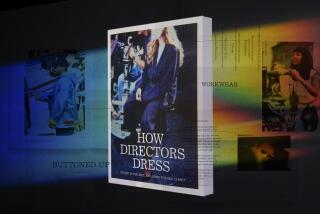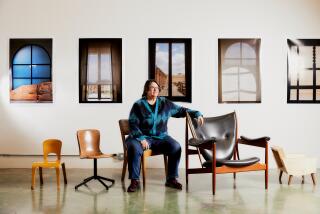AROUND HOME : A Director’s Chair
- Share via
TO PARAPHRASE Gertrude Stein, a chair is a chair is a chair. Nothing proves the dictum better than the director’s chair, whose form and proportion date back as far as Egyptian folding stools from the 15th Century BC. Similar seating abounded in Greece and Rome, but then folding furniture lost favor to heavier forms until Napoleon popularized a leather-and-steel version that he carried on his military campaigns.
The genre didn’t prosper, however, until the Industrial Revolution began uprooting worker hordes from farms to tight urban quarters, fueling the demand for folding furniture. In particular, the crisscross legs proved ideal. Designers paired the two sets of legs (either left to right or front to back), with a collapsible metal brace; when locked it offered stability, unlocked it allowed the seat, arms and legs to fold into a compact unit.
Gold Medal Inc. of Racine, Wis., began manufacturing such a chair in the 1860s--still sold everywhere today as the generic director’s chair. Twentieth-Century designers have added their personal touches to the prototype: Stitched-leather arm straps adorn the 1932 MK chair of Mogens Koch, a pioneer of Danish Modern. Closer to our own time, the Milanese trinity of De Pas, D’Urbino, Lomazzi (better known for their Pop Art-inspired “Joe DiMaggio” chair, shaped like an enormous baseball catcher’s mitt) developed the Sanremo folding chair in 1975, an elegant director’s chair with canvas slings. Slightly earlier came the April folding chair in stainless steel by their compatriot Gae Aulenti, designer of the Adriana Vittadini boutique on Rodeo Drive in Beverly Hills.
Sadly, even the priciest version offers inadequate lumbar (lower back) support. Fidgeting after five minutes--and a backache after an hour--is virtually guaranteed. Still, few buyers care about the chair’s discomfort, or for that matter exploit its collapsibility. What attracts them is the chair’s symbolism as Hollywood’s ultimate power chair. After all, film crews spend millions of dollars schlepping equipment from location to location; they could easily haul a more substantial chair along with the cameras and cranes. But what other seat so befits a Hollywood mogul? As designer Ralph Caplan puts it, “The function of the movie director’s chair is to carry the name of the director. That’s why we all like them, although they can be hell to sit in.”
Director chairs are widely available throughout Southern California.


